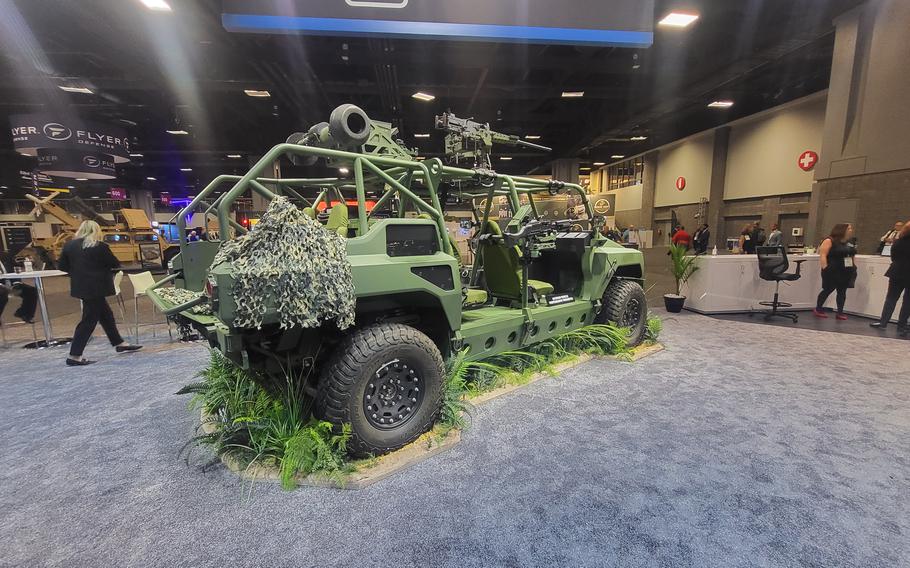
GM Defense’s Electric Military Concept Vehicle, which holds six people and is based on the GMC Hummer electric vehicle pickup, is seen at Modern Day Marine 2023 at the Walter E. Washington Convention Center in Washington on Wednesday, June 28, 2023. (Doug G. Ware/Stars and Stripes)
WASHINGTON — Prototypes of a highly mobile piece of equipment that stores electricity is being developed to produce cleaner energy, reduce dependency on fossil fuel and improve troops’ edge on the battlefield. And it is based on technology that is already in vehicles on the road.
“You’ve got all of these diesel generators [the military uses now] … and the whole time they are guzzling diesel fuel,” JD Johnson, vice president of business development for the defense subsidiary of General Motors, said Wednesday at the Modern Day Marine 2023 convention in Washington.
GM Defense’s proposed Electric Storage Unit is roughly the same size as the existing diesel generators that the military uses now, making them mobile. If deployed, the company officials said they would replace many of the old diesel generators, requiring only a few for recharging. A management system built into the new unit can turn the diesel generators on and off only when they need recharging, thus reducing fuel consumption and carbon emissions.
The Defense Department is the single largest institutional consumer of fossil fuels in the world and emits more greenhouse gas than two-thirds of all the nations on Earth, according to the Pentagon. The military in recent years has made moves away from using fossil fuels for its contribution to climate change, which Defense Secretary Lloyd Austin has called an “existential threat” to national security. The Army released a plan last year to cut down on fossil fuel use, invest in renewable energy sources and become more resilient in difficult weather conditions.
GM Defense and Cummins Power Generation were chosen this week to build electric storage prototypes as part of the Defense Innovation Unit’s program called Stable Tactical Expeditionary Electric Power, or STEEP. The main goal of the program is to develop a “modular, vehicle transportable system” that provides various forms of alternate energy storage and “management for tactical and mobile microgrids” in rugged and remote environments. The DIU — established by the Pentagon in 2015 to help the military make faster use of emerging technologies — expects the new technology to cut down on logistical challenges and fossil fuels as the military’s main energy source.
If successful, STEEP will transition to a Marine Corps program, but Johnson said the Army also has interest in the GM’s energy storage technology.
The Army is already using one of the company’s other new developments — a nine-seat Infantry Squad Vehicle. A four-seat variant known as the ISV4, which is heavily based on the Chevrolet Colorado pickup truck, was on display at GM Defense’s booth at the convention.
Also on display Wednesday was GM’s Electric Military Concept Vehicle, a dual-motor, SUV-like truck that’s based on the GMC Hummer electric vehicle pickup. The company is also developing the hybrid-powered Next Generation Light Tactical Wheeled Vehicle that’s based on the Chevrolet Silverado pickup.
The Electric Storage Unit and its military electric vehicles use the automaker’s Ultium flexible battery platform, which already powers several of the company’s commercial vehicles.
“We are trying to help the Marines and different U.S. military services to see the [electric] tactical grid,” said Sonia Taylor, GM Defense’s director of communications. “It’s an ecosystem we’re trying to help build, that you can have a more electric presence … while also delivering significant tactical capabilities.”
According to the DIU, GM Defense and Cummins in the future will produce multiple prototypes for the military to evaluate and test. The Pentagon is expected to select the winner in 2026, according to the company.
“These commercial technologies will provide the [Pentagon] with new capabilities to more efficiently manage our tactical microgrids by optimizing our power management in remote environments,” said Jack Ryan, program manager for the Defense Innovation Unit. “This translates to reduced supply chain constraints, less down time for the warfighter, and increased energy availability in the field.”